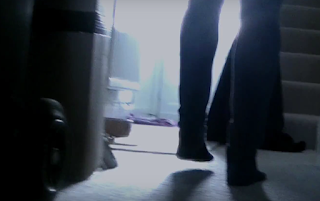How did you attract/address your audience?
Genre Conventions
Our film appeals to those who want to be challenged when watching a film in which the motif or story behind the film is not clear. Films such as Psycho, 1990 (Alfred Hitchcock) would fall under this bracket as you are constantly questioning what is reality and who can they trust, this keeps the audience on the edge of their seat. In most high budget films the narrative is more or less 'spoon fed' to the audience. One is not challenged mentally when watching say 'Die Hard 3'. And so this was a key feature we thought pyshcological thrillers break the mould in and challenge people to come up with their own narrative. The theme of reality and non-reality was also used in the Christopher Nolan's Inception, 2010, where by the simple use of a spinning top the audience would find out whether or not the scene was a reality or not. The final scene ends with Dom Cobb (Leonardo Di Caprio) being re-united with his children after being cleared of criminal charges. He spins the spinning top and then goes to play with his kids. However the spinning top remains spinning for a while and one starts to think, is he in reality or not.
 |
| The final scene of Inception |
Not only have we tried to provide a twist in the sense that the antagonist is not who one believes him to be but we have also subverted the gender roles. To gain recognition for our film introduction we have both subverted and conformed to gender stereotypes in thriller. We have used Izzi Harrison as our victim who is seen as peit and pretty and a character that the audience can warm to. In contrast we used Candice Feddis as our lead detective. She was a powerful actor, much like that of Viola Davis in Suicide Squad, who acts as a source of empowerment for the viewer and this alternative view on how gender can be presented would be enlightening for the audience. This is a key aspect of our USP as still to this day most thrillers have a narrative in which the woman is the victim of abuse or murder. Including both a strong and vulnerable woman widens our target audience.
Sound and Music
Looking back on our initial audience research into what out target audience want from a psychological thriller and their opinions on current thrillers, 60% of voters wanted the plot to be built through music and 20% through visuals. For audience purposes we incorporated both of these into our film introduction. Katie Finch was the pianist for the non diegetic music. She builds up the atmosphere as she starts slow, with the antagonist walking up the stairs, and then when the audience is introduced to the victim the music builds. This can be seen in Stephen Spielberg's 'Jaws' where the music builds up to a climax. The slow music is unique to our film as the music appears to slow down the scene, allowing the audience to notice events in the scene. This can be seen when the music reduces in volume and the audience's attention is brought to the diegetic enhanced dripping noise, symbolic of the end of some.
Pace and Editing
In addition we edited the scene in a slow manner. Due to such a complex story we thought it would be neccesary to slow everything allowing the audience to see the twist in the plot and to get to know the characters personality. Using dissolves and fade to blacks we made the audience feel immersed in the action due through match on action in the bedroom. This technique is also used in Inception where we see non diegetic opera music to enhance the drama and create the illusion of slowing down the music.
Mise en Scene
We drew people into the action by enhancing the sinister tone. This was first achieved by the connotations provided by the light. In the bedroom scene and in the detective scene we see a natural light shining through a two shot. This connotes innocence but also vulnerability, especially with the victim. Ben Nixon was wearing a black jumper throughout which has connoations to deep love, obsession or death. Candice Feddis also highlighted how she was suberting gender roles as she wore a brown shirt and black trousers, commonly linked to that of a working man. This shows that she is suberting the stereotype that only men are serious workers and providers.

















